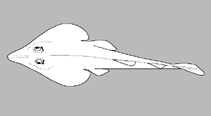Rhinobatos ranongensis Last, Séret & Naylor, 2019
Ranong guitarfish
Common names from other countries
分類 / Names 共通名の | 類義語 | Catalog of Fishes(部類, 種) | ITIS | CoL | WoRMS | Cloffa
板鰓亜鋼(サメとエイ類) (sharks and rays) > Rhinopristiformes (Shovelnose rays) > Rhinobatidae (Guitarfishes)
Etymology: Rhinobatos: Greek, rhinos = nose + Greek, batis, -idos = a ray (Raja sp.) (Ref. 45335); ranongensis: Named for the Ranong fish landing in western Thailand, where the first specimen was collected 25 years ago, and subsequently most of the types.
Etymology: Rhinobatos: Greek, rhinos = nose + Greek, batis, -idos = a ray (Raja sp.) (Ref. 45335); ranongensis: Named for the Ranong fish landing in western Thailand, where the first specimen was collected 25 years ago, and subsequently most of the types.
Environment: milieu / climate zone / depth range / distribution range 生態学
海 底生の; 深さの範囲 30 - 69 m (Ref. 123963). Tropical
分布 国々 | 国連食糧農業機関の区域 | エコシステム | 事件 | Point map | 導入 | Faunafri
Eastern Indian Ocean: Andaman Sea, Myanmar and western Thailand.
サイズ / 重さ / 年齢
Maturity: Lm ? range ? - ? cm
Max length : 64.5 cm TL オス/雌雄の選別がない; (Ref. 123963); 51.1 cm TL (female)
Max length : 64.5 cm TL オス/雌雄の選別がない; (Ref. 123963); 51.1 cm TL (female)
簡単な記述 検索表 | 形態学 | 形態計測学
This medium-sized species is distinguished by the following set of characters in adult male: disc is wedge-shaped and relatively narrow, its width 31-33% TL, length 1.3-1.4 times width; snout moderately elongate, its length 3.0–3.2 times interspiracular distance, 4.1-4.4 times interorbital width; orbit and spiracular openings are small, orbit diameter ~1.5 times spiracle length; nostrils weakly oblique, length 1.3-1.6 times internarial distance; mouth narrow, 5.4-6.0% TL; preoral length 6.3-6.9 times internarial distance; posterior nasal flaps are broad; spiracular folds 2, the outermost fold slightly taller than inner fold; ridges of rostral cartilage are almost parallel, converging anteriorly but not constricted medially; anterior cartilage is broadly sickle shaped, truncate posteriorly; gill slits and their interspaces are narrow, distance between fifth gill slits 3.0-3.2 times in ventral head length; prebranchial sensory pore system distinct, extending to just behind margin of first gill slit; postscapular sensory canal indistinct, deeply embedded, not forming shallow groove; thorn patches present on supraorbit and scapular region, and row along dorsal midline rudimentary, inconspicuous; denticles on dorsal fins are densest anteriorly, present but more sparse posteriorly; dorsal fins are small, height of first 5.4-6.2% TL; pelvic-fin inner margin subequal to its base length; interdorsal distance 2.9-3.3 times first dorsal-fin base; dorsal caudal margin 2.0-2.4 times the preventral margin; upper jaw with 68-82 tooth rows; snout angle 59-64°; pectoral radials 64-68; post-synarcual centra 172-176; nasal lamellae 47-48. Colouration: dorsal fins brownish anteriorly, dusky posteriorly; dorsal disc of adults largely uniformly brownish, no spots or obvious blotches; no large, black, teardrop marking on undersurface of snout (Ref. 123963)
Caught individuals: males at 49.4 and 50.3 cm TL were immature and the largest female (51.1 cm TL) was most probably at late adolescent or early mature stage of development (Ref. 123963).
Life cycle and mating behavior 成熟 | 繁殖 | 放精 | 卵 | 生産力 | 幼生
主な参考文献
Upload your references | 参考文献 | コーディネーター : McEachran, John | 協力者
Last, P.R., B. Séret and G.J.P. Naylor, 2019. Description of Rhinobatos ranongensis sp. nov.(Rhinopristiformes: Rhinobatidae) from the Andaman Sea and Bay of Bengal with a review of its northern Indian Ocean congeners. Zootaxa 4576(2):257-287. (Ref. 123963)
人間に対する脅威
Harmless
Human uses
FAO(Publication : search) | FishSource |
より多くの情報
Trophic ecology
食品種目概要について
餌の構成
摂食量
Food rations
捕食動物
食品種目概要について
餌の構成
摂食量
Food rations
捕食動物
Ecology
生態学
Home ranges
生態学
Home ranges
Population dynamics
成長のパラメーター
Max. ages / sizes
Length-weight rel.
Length-length rel.
体長組成
Mass conversion
補充
豊度
成長のパラメーター
Max. ages / sizes
Length-weight rel.
Length-length rel.
体長組成
Mass conversion
補充
豊度
Life cycle
繁殖
成熟
生産力
放精
Spawning aggregations
卵
卵の開発
幼生
幼生の動力
繁殖
成熟
生産力
放精
Spawning aggregations
卵
卵の開発
幼生
幼生の動力
Anatomy
カマ
Brain
Otolith
カマ
Brain
Otolith
Physiology
Body composition
Nutrients
酸素消費
水泳形態
泳ぐ速さ
Visual pigments
Fish sound
Diseases & Parasites
Toxicity (LC50s)
Body composition
Nutrients
酸素消費
水泳形態
泳ぐ速さ
Visual pigments
Fish sound
Diseases & Parasites
Toxicity (LC50s)
Genetics
遺伝子の
Heterozygosity
遺伝
遺伝子の
Heterozygosity
遺伝
用具
E-book | 野外観察図鑑 | Length-frequency wizard | 生活史の基盤ツール | 目的のマップ | Classification Tree
| Catch-MSY |
特記事項
XMLをダウンロードして下さい
インターネットの情報源
Aquatic Commons | BHL | Cloffa | Websites from users | Check FishWatcher | CISTI | Catalog of Fishes(部類, 種) | DiscoverLife | ECOTOX | Faunafri | Fishtrace | GenBank(ゲノム, ヌクレオチド) | GloBI | GOBASE | | Google Books | Google Scholar | Google | IGFA World Record | MitoFish | Otolith Atlas of Taiwan Fishes | PubMed | Reef Life Survey | Scirus | SeaLifeBase | 生命の木 | Wikipedia(行く, 検索する) | World Records Freshwater Fishing | Zoobank | 動物に関する記録
Estimates based on models
Phylogenetic diversity index (Ref. 82804): PD50 = No PD50 data [Uniqueness, from 0.5 = low to 2.0 = high].
Bayesian length-weight: a=0.00295 (0.00151 - 0.00578), b=3.13 (2.96 - 3.30), in cm Total Length, based on LWR estimates for this (Sub)family-body shape (Ref. 93245).
栄養段階 (Ref. 69278): 3.7 ±0.4 se; based on size and trophs of closest relatives
回復力 (Ref. 120179): 低い, 4.5年~14年の倍増期間の最小個体群 (Preliminary low fecundity).
Fishing Vulnerability (Ref. 59153): Moderate to high vulnerability (46 of 100).




